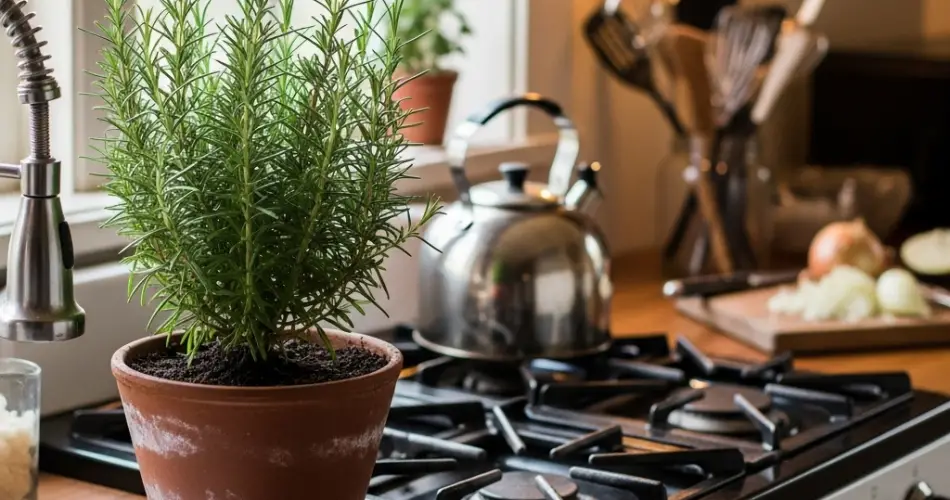Rosemary is more than just an herb; it is a kitchen essential that brings fragrance, flavor, and a touch of elegance to everyday cooking. Known for its woody stems and needle-like leaves, rosemary is a versatile herb that pairs well with a wide range of dishes, from roasted meats and vegetables to breads and infused oils. Keeping a pot of rosemary by your stove not only adds a beautiful touch of greenery to your kitchen but also ensures that this flavorful herb is always within arm’s reach whenever you need it.
Why Grow Rosemary Indoors?
Many home cooks buy rosemary sprigs at the market, only to find them drying out in the fridge after a few days. By keeping a living rosemary plant near your cooking space, you ensure a continuous supply of fresh leaves whenever inspiration strikes. Beyond convenience, rosemary also has practical benefits:
-
Aromatic touch: Its natural fragrance adds freshness to the kitchen environment.
-
Easy care: Rosemary is hardy and can thrive indoors with minimal attention.
-
Decorative value: Its upright growth habit and evergreen needles make it an attractive plant to display near the stove or kitchen window.
Growing rosemary indoors also allows you to control the plant’s environment, protecting it from harsh weather, pests, and diseases that can affect outdoor herbs.
Choosing the Right Container
Rosemary grows best in containers that allow for proper drainage. Select a pot with holes at the bottom to prevent waterlogging, as the herb does not tolerate soggy soil. A clay or terracotta pot is often ideal because it allows excess moisture to evaporate, keeping the roots healthy.
The size of the container depends on how large you want your rosemary to grow. For compact kitchen spaces, a medium-sized pot is sufficient. As the plant matures, you can repot it into a larger container if you want to encourage more growth.
Light and Placement
Rosemary loves sunlight and requires at least six to eight hours of direct light daily. Position your plant near a bright kitchen window, ideally one facing south or west, where it can soak in the most natural light. If your kitchen lacks strong sunlight, consider using a grow light to supplement.
Placing rosemary close to the stove is convenient, but be mindful of heat from cooking, which can dry the plant out if it is too close to burners. Ensure it gets adequate airflow and is not exposed to intense heat blasts.
Watering and Care
One of the most common mistakes with rosemary is overwatering. This herb prefers slightly dry soil and does not like its roots to sit in water. Water thoroughly only when the top inch of soil feels dry, and allow excess water to drain.
Rosemary also appreciates occasional misting to mimic the humidity of its natural Mediterranean environment, especially in kitchens where indoor air may be dry. Fertilize once a month during the growing season with a balanced, water-soluble fertilizer to encourage strong growth.
Pruning is another key to keeping your rosemary healthy. Regularly trim back the tips of the plant, both to harvest and to encourage branching. A well-pruned plant stays bushy, compact, and productive.
Harvesting Rosemary
The beauty of keeping rosemary near your stove is the ability to harvest fresh leaves at any time. Use sharp scissors to snip off stems as needed, cutting just above a pair of leaves to encourage regrowth. Avoid cutting more than one-third of the plant at once, as this can stress it.
Fresh rosemary sprigs can be used immediately in cooking or stored in the fridge wrapped in a damp paper towel for a few days. You can also dry excess sprigs by hanging them upside down in a cool, dark place, then storing the dried leaves in airtight containers.
Culinary Uses
Rosemary is a powerhouse in the kitchen, offering flavor that is bold, earthy, and slightly piney. Some popular ways to use it include:
-
Roasts: Add sprigs to chicken, beef, or lamb for a fragrant infusion.
-
Vegetables: Toss chopped rosemary with potatoes, carrots, or squash before roasting.
-
Breads: Infuse focaccia or homemade loaves with rosemary leaves.
-
Soups and stews: Enhance broths and slow-cooked meals with sprigs of rosemary.
-
Herbal infusions: Steep rosemary in oil, vinegar, or even tea for unique flavor twists.
Its strong flavor means a little goes a long way, making it one of the most impactful herbs you can keep at home.
The Charm of Kitchen Rosemary
Beyond its culinary uses, rosemary has long been valued for its symbolism and natural properties. It has been associated with memory, focus, and even protection. Having it by the stove blends tradition with practicality, turning a simple herb into both a cooking tool and a meaningful presence in your home.
Final Thoughts
For home cooks, rosemary by the stove is more than a decorative plant — it is a flavorful companion that enhances both cooking and the atmosphere of the kitchen. With its ease of care, versatility, and year-round availability, rosemary deserves a permanent spot in your kitchen garden. Whether you are seasoning a roast, baking fresh bread, or simply enjoying its fresh scent, this herb will quickly become indispensable in your culinary routine.



